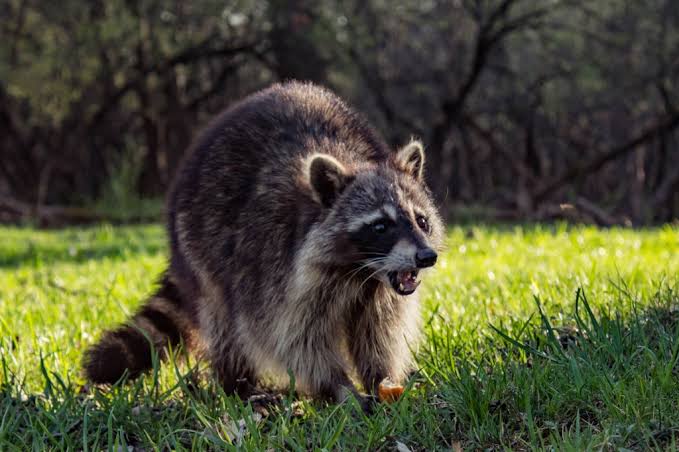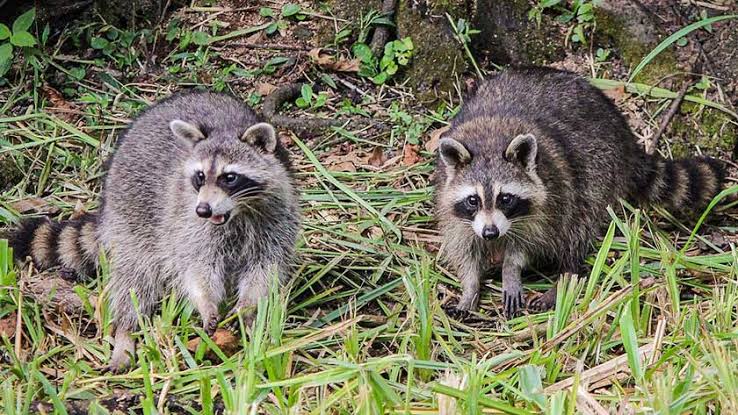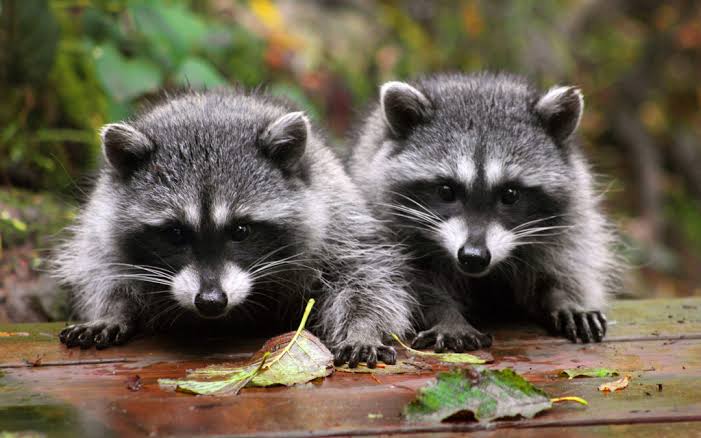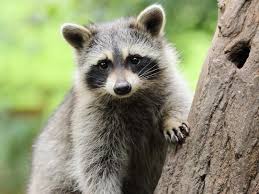Raccoons, scientifically known as Procyon lotor, are fascinating creatures that capture the imagination with their clever antics and distinctive appearance. These medium-sized mammals are native to North America and are known for their iconic black mask-like markings around their eyes.
In the wild, raccoons inhabit a variety of environments, ranging from forests and marshes to urban areas. Their adaptability has enabled them to thrive in diverse habitats, making them a common sight for people across the continent. One of the most noticeable features of raccoons is their bushy, ringed tail, which adds to their charm.
Raccoons are opportunistic omnivores, meaning they eat a wide range of foods. Their diet includes fruits, nuts, insects, small mammals, and even human leftovers when scavenging in urban areas. This adaptability to different food sources contributes to their ability to survive in various environments.
Nocturnal by nature, raccoons are primarily active during the night. Their keen sense of hearing and sharp claws make them skilled foragers in the dark. Their front paws are highly dexterous, allowing them to manipulate objects with remarkable precision, almost resembling human hands.
These creatures are known for their intelligence and problem-solving skills. Raccoons have been observed displaying complex behaviors, such as opening latches, turning doorknobs, and even solving simple puzzles. This cognitive adaptability has led to them successfully navigating both natural and human-altered landscapes.
Female raccoons, known as sows, give birth to litters of three to seven kits in the spring. The young raccoons stay with their mother for several months, learning essential survival skills before becoming independent. This family-oriented behavior adds another layer to the social dynamics of raccoon communities.
While raccoons are intriguing animals, they can sometimes pose challenges to human communities. Their scavenging behavior can lead to conflicts when they rummage through garbage cans or invade human living spaces. However, coexisting with raccoons often involves understanding their habits and taking preventative measures to avoid potential issues.
Procyon lotor, or the raccoon, exemplifies nature’s adaptability and intelligence. From their distinctive markings to their problem-solving prowess, these creatures continue to captivate the curiosity of those who encounter them. As urban and rural landscapes intertwine, finding ways to peacefully coexist with raccoons remains an important aspect of appreciating the diversity of the natural world.
Read Also: Pigs Breeding Cycle and Recommended Practices
Animals and Plants Affected by Raccoons (Procyon lotor)

Raccoons, with their versatile diet and adaptability, can have an impact on various animals and plants in their ecosystems. Their scavenging behavior and foraging habits may influence the local environment. For example, raccoons can affect:
1. Small Mammals: Raccoons are opportunistic predators, and they may have an impact on small mammal populations. They may feed on eggs, nestlings, or even adult individuals of smaller mammals, influencing the dynamics of local rodent or bird populations.
2. Bird Nests: Birds, especially ground-nesting species, may face challenges from raccoons predating on their eggs or young chicks. This can potentially affect bird populations in an area, particularly those that are vulnerable during nesting seasons.
3. Amphibians and Reptiles: Raccoons are known to consume amphibians and reptiles, including their eggs. This can have consequences for local populations of frogs, salamanders, and reptiles, especially if raccoons become abundant in an area.
4. Insects and Invertebrates: Raccoons have a diverse diet that includes insects and invertebrates. While their foraging may help control certain pest populations, it can also have unintended consequences on beneficial insects or invertebrates in the ecosystem.
5. Fruit and Nut Trees: Raccoons are omnivores and consume fruits and nuts. In agricultural or backyard settings, they may raid fruit trees or nut-bearing plants, potentially impacting local harvests or the reproduction of certain plant species.
6. Garbage Bins: In urban areas, raccoons are notorious for scavenging through garbage bins. This behavior not only leads to messy surroundings but also contributes to conflicts between raccoons and humans, as they may spread waste and disrupt local waste management systems.
7. Pet Food and Domestic Poultry: Raccoons may raid outdoor pet food bowls or target domestic poultry. This can lead to conflicts with pet owners or farmers, as raccoons seek easy access to food sources provided by humans.
While raccoons play a natural role in ecosystems, their interactions with other species can sometimes result in challenges. Understanding these dynamics is essential for managing and mitigating potential conflicts between raccoons and the broader environment they inhabit.
Damages Caused by Raccoons

Raccoons can cause various damages, particularly when their behavior intersects with human habitats. Some common damages caused by raccoons include:
1. Property Damage: Raccoons are skilled climbers and may access roofs, attics, or chimneys, causing structural damage as they seek shelter. They may tear off shingles, rip open vents, or damage insulation in the process.
2. Garden and Crop Damage: In rural and suburban areas, raccoons can be a nuisance in gardens. They may dig up lawns in search of insects, raid vegetable patches, and damage crops. Their adept paws can wreak havoc on plants and flowers.
3. Garbage Can Raids: Raccoons are notorious for rummaging through garbage bins in both urban and suburban settings. This behavior not only creates a mess but also poses sanitation issues. Raccoons may scatter trash in their search for food, leading to neighborhood complaints.
4. Pet and Poultry Interference: Raccoons may target outdoor pet food bowls or attempt to prey on domestic poultry. This can lead to confrontations with pet owners or farmers, potentially resulting in injuries to pets or loss of poultry.
5. Destruction of Bird Nests: Raccoons, being opportunistic predators, may raid bird nests for eggs or young chicks. This can impact local bird populations and disrupt the natural balance in ecosystems, especially for ground-nesting species.
6. Transmission of Diseases: Raccoons can carry and transmit various diseases, including rabies, roundworm, and leptospirosis. Their presence in close proximity to humans and pets increases the risk of disease transmission, emphasizing the importance of avoiding direct contact.
7. Electrical Wiring Damage: In some cases, raccoons may chew on electrical wiring, posing a fire hazard. This behavior can occur when raccoons gain access to attics or crawl spaces where electrical wiring is present.
8. Damage to Beehives: Beekeepers may face challenges from raccoons attempting to access beehives. Raccoons can cause damage to hives, potentially harming bee colonies and impacting honey production.
While raccoons are part of the natural ecosystem, conflicts arise when their activities overlap with human spaces. Effective management strategies, such as securing garbage cans, repairing potential entry points to homes, and using deterrents, can help mitigate damages and promote coexistence.
Read Also: Guide to Proper Management of Piglets
Control and Preventive Measures

Implementing control and preventive measures is essential for managing raccoon-related issues and promoting harmonious coexistence. Here are some effective strategies:
1. Secure Garbage Bins: Use tightly sealed and lockable garbage bins to prevent raccoons from accessing and scattering trash. This helps reduce the incentive for raccoons to forage in residential areas.
2. Remove Outdoor Food Sources: Avoid leaving pet food outdoors, and secure any potential food sources that might attract raccoons. This includes bird feeders, which can be a tempting target.
3. Seal Entry Points: Conduct a thorough inspection of your home and seal any potential entry points, such as gaps in roofs, vents, or chimneys. Raccoons are excellent climbers, so securing entry points at height is crucial.
4. Install Chimney Caps and Vent Screens: Adding caps to chimneys and screens to vents can prevent raccoons from entering buildings. This helps protect attics and crawl spaces from their intrusion.
5. Install Motion-Activated Lights or Sprinklers: Raccoons are nocturnal, and they are often deterred by sudden bright lights or water. Installing motion-activated lights or sprinklers can discourage raccoons from entering specific areas.
6. Use Raccoon-Resistant Bird Feeders: If you enjoy feeding birds, consider using bird feeders designed to be raccoon-resistant. These typically have mechanisms that make it difficult for raccoons to access the feed.
7. Employ Natural Deterrents: Certain scents, such as ammonia or predator urine, can act as natural raccoon deterrents. Placing these around potential entry points or areas of concern may discourage their presence.
8. Trim Tree Branches: Trim branches that provide raccoons easy access to roofs or other potential entry points. Raccoons are skilled climbers, so limiting their access points helps reduce the risk of them entering buildings.
9. Consult Professionals: If raccoon issues persist or if there’s evidence of raccoons living in or around your property, consider consulting wildlife professionals or pest control experts. They can provide advice, assess the situation, and, if necessary, implement humane removal methods.
10. Vaccinate Pets: If you have pets, ensure they are vaccinated, particularly against rabies. This precaution is crucial if there’s a potential for contact between pets and raccoons.
By combining these preventive measures, individuals can significantly reduce the likelihood of raccoon-related problems and create an environment where both humans and raccoons can coexist with minimal conflicts.
Frequently Asked Questions (FAQs) About Raccoons (Procyon lotor)
1. Q: Are raccoons dangerous to humans?
A: While raccoons generally avoid direct contact with humans, they can become aggressive if cornered or feel threatened. Additionally, raccoons may carry diseases such as rabies, so it’s essential to avoid close interactions.
2. Q: How can I keep raccoons out of my garbage?
A: Use tightly sealed and lockable garbage bins to prevent raccoons from accessing trash. Additionally, avoid leaving garbage bags exposed and consider placing bins in secure enclosures.
3. Q: What do raccoons eat?
A: Raccoons are omnivores and have a varied diet. They consume fruits, nuts, insects, small mammals, and even human leftovers. Their adaptability allows them to thrive in diverse environments.
4. Q: Can raccoons climb?
A: Yes, raccoons are excellent climbers. They use their sharp claws and dexterous paws to climb trees, buildings, and structures. This ability helps them access various habitats and food sources.
5. Q: How do I deter raccoons from my property?
A: Secure potential food sources, seal entry points to your home, use deterrents like motion-activated lights or sprinklers, and employ natural scents like ammonia to discourage raccoons.
6. Q: Do raccoons hibernate?
A: Raccoons do not hibernate but may become less active during extremely cold weather. They are opportunistic and continue to forage for food throughout the year.
7. Q: Are raccoons carriers of diseases?
A: Yes, raccoons can carry diseases such as rabies, roundworm, and leptospirosis. It’s crucial to avoid direct contact with raccoons and vaccinate pets to minimize health risks.
8. Q: What should I do if I find a baby raccoon?
A: If you encounter a baby raccoon, observe from a distance as the mother may be nearby. If the baby appears injured or abandoned, contact local wildlife authorities for guidance on proper care or intervention.
9. Q: Can raccoons be relocated?
A: Relocating raccoons is often discouraged as it can lead to stress and the spread of diseases. In many areas, wildlife professionals must be consulted for humane and legal handling of raccoon-related issues.
10. Q: How can I protect my garden from raccoons?
A: Use fencing, secure garbage bins, and consider natural deterrents. Harvest fruits and vegetables promptly, and avoid leaving pet food outside, as these measures can help protect your garden from raccoon interference.
Read Also: How to Write an Essay

